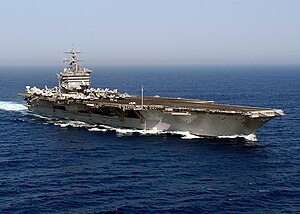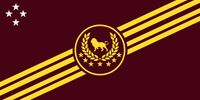USRN Triumph
Jump to navigation
Jump to search
 USRN Triumph in August 1964
| |
| History | |
|---|---|
| Name: | Triumph |
| Ordered: | 4 August 1955 |
| Builder: | Ironforge International Shipbuilding |
| Cost: |
|
| Laid down: | 2 August 1955 |
| Launched: | 29 September 1959 |
| Sponsored by: | Admiral Justyne Tettidia Arcavia |
| Commissioned: | 14 October 1959 |
| Reclassified: | CV-2 |
| Identification: |
|
| Fate: | Active Service |
| General characteristics | |
| Class and type: | Aircraft Carrier |
| Displacement: |
|
| Length: | 1,046 ft (319 m) |
| Beam: |
|
| Draft: | 37 ft (11 m) |
| Propulsion: |
|
| Speed: | 34 knots (63 km/h; 39 mph) |
| Complement: | 3,826 officers and men. |
| Sensors and processing systems: |
|
| Electronic warfare & decoys: | MK.XII SEW-CMS |
| Armament: |
|
| Aircraft carried: | 70–90 |
The USRN Triumph (CV-2) is the second and last of two Carpathia conventional carriers built for the United States of Sera Royal Navy in the 1950s. Her sister ship, the USRN Victory served as the pride of the Royal Navy and naval flagship while the Triumph served as the flagship of the second fleet. Although both ships of the class were later fitted with catapult launchers, both carriers were initially built with angled decks to propel aircraft into the air.
History
Engagements and Service
Awards
This article is incomplete because it is pending further input from participants, or it is a work-in-progress by one author. Please comment on this article's talk page to share your input, comments and questions. Note: To contribute to this article, you may need to seek help from the author(s) of this page. |
